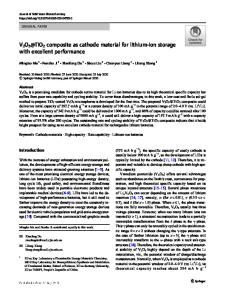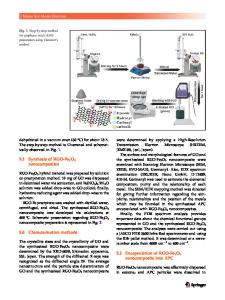Synthesis and study of V 2 O 5 /rGO nanocomposite as a cathode material for aqueous zinc ion battery
- PDF / 1,398,580 Bytes
- 9 Pages / 595.276 x 790.866 pts Page_size
- 81 Downloads / 329 Views
ORIGINAL PAPER
Synthesis and study of V2O5/rGO nanocomposite as a cathode material for aqueous zinc ion battery Shiyu Wang 1,2 & Kunjie Zhu 4 & Linyu Yang 1,2 & Huizhong Li 2,3 & Shuying Wang 1 & Shasha Tang 5 & Min Zhang 1 & Ablat Abliz 1 & Fengjun Zhao 2,3 Received: 15 May 2020 / Revised: 14 July 2020 / Accepted: 15 July 2020 # Springer-Verlag GmbH Germany, part of Springer Nature 2020
Abstract Vanadium-based material is currently one of the most suitable materials for constructing aqueous ZIB. In this work, commercial V2O5 has also been used for comparing the battery’s performance with the V2O5-rGO (reduced graphene oxide) nanocomposite products. The commercial V2O5 showed poor cycle stability and low specific capacity (30 mA h g−1 specific capacity was observed after 200 cycles), while the V2O5 nanobelts/rGO composite showed good performance. After applying a current density of 0.1 A g−1, V2O5 nanobelts/rGO showed an outstanding cycle stability and high specific capacity of 135 mA h g−1 after 200 cycles. In the rate performance, when a current density of 1 A g−1 was applied, a high specific capacity of 113 mA h g−1 was obtained. Compared with the commercial V2O5, V2O5 nanobelts/rGO composite depicts superior performance as an electrode material for aqueous ZIB. Keywords V2O5 nanobelts/rGO . V2O5 composites . Commercial V2O5 . Aqueous zinc ion battery
Introduction In recent years, owing to the improvement in standard of living, portable mobile devices, and transport tools Electronic supplementary material The online version of this article (https://doi.org/10.1007/s11581-020-03705-3) contains supplementary material, which is available to authorized users. * Kunjie Zhu [email protected] * Linyu Yang [email protected] * Shuying Wang [email protected] 1
School of physics and technology, Xin Jiang University, Urumqi, Xinjiang 830000, China
2
State Key Laboratory of Powder Metallurgy, Central South University, Changsha, China
3
Key Laboratory of Advanced Energy Materials Chemistry (Ministry of Education), College of Chemistry, Nankai University, Tianjin 300071, China
4
School of Materials Science and Engineering, Central South University, Changsha 410083, Hunan, China
5
School of Physical and Mathematical Sciences, Nanyang Technological University, Singapore 637371, Singapore
have shown increased usage. Further, it is well-known that the current sources of clean energy such as wind, tidal, and solar cannot provide continuous and stable power for transmission, owing to their high degree of randomness.[1–5] Therefore, a reliable energy storage device which is operable on a large scale is required. In addition, the increase in electric power consumption requires the demand for high-performance energy storage equipment to be met urgently. Among the many available options, lithium-ion battery (LIB) has become one of the major providers of energy storage devices in the market, due to its high specific capacity.[6, 7] Owing to the in-depth research conducted on LIB systems, some of their sh
Data Loading...











